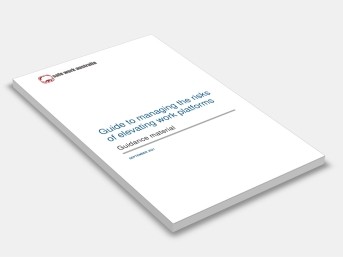Guide to managing the risks of elevating work platforms
Safe Work Australia
September 2021
Elevating work platforms (EWPs) can pose a number of work health and safety (WHS) risks. This guide provides information to a person conducting a business or undertaking (PCBU) on:
-
identifying and assessing the risks of EWPs
-
control measures for managing the risks of EWPs, and
-
safe planning and use of EWPs.
The guide covers: What is an elevating work platform, who has health and safety duties, managing health and safety duties, planning and preparation, safe operation of an EWP, and working near electric lines. Includes a pre-operational checklist.
Contents:
1: Introduction
1.1: What is an elevating work platform?
1.2: Who should use this guide?
1.3: How to use this guide
2: Who has health and safety duties?
2.1: WHS laws in your state or territory
3: Managing health and safety risks
3.1: Consultation
3.2: The risk management process
3.2.1: Identify the hazards
3.2.2: Assess the risks
3.2.3: Take action to control the risks
3.2.4: Maintain and review the control measures
3.3: Information, training, instruction and supervision
3.4: Licensing requirements
3.5: Inspections
3.6: Emergency plans
3.7: Safe work method statements
3.8: Record keeping
4: Planning and preparation
4.1: Selecting the right EWP
4.2: Registering an EWP
4.3: Preventing collisions
4.4: Pre-use safety checks
5: Safe operation of an EWP
5.1: EWP controls
5.2: Spotters
5.3: Operating procedures
5.4: Exclusion zones
5.5: Falls from a height
5.6: Telehandlers
5.7: Hazardous substances
6: Working near electric lines
6.1: Approach distances
6.2: Controlling risks
6.3: Approach distances for vehicles
6.4: The safety observer zone
6.5: Safety observer
6.6: Training and competence
6.7: Contact with power lines
Appendix A: Pre-operational checklist
